Jellyfish in an aquarium: what are they and how to keep them?

Jellyfish are rare in an aquarium. Mostly they can be seen in aquariums. At home, you need to spend a lot of labor and money to keep fragile beauties. Those who succeed in this get a mesmerizing sight. Beautiful, in fact, unearthly creatures hang in layers of water. It is difficult to look away from the amazing translucent figures.
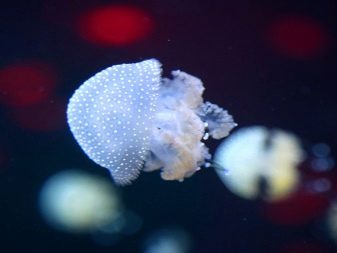
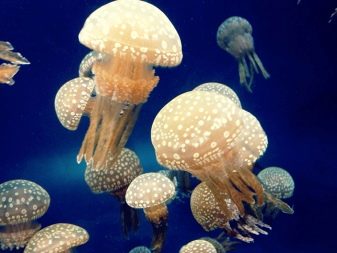
Peculiarities
Most jellyfish live in sea waters, but there are freshwater species that are used for keeping in aquariums. These are invertebrates, they belong to the type of cnidarians (cnidarians). About 10 thousand species of such organisms live in the waters of the Earth. They lack the brain, kidneys, stomach, intestines, organs of vision. Their digestive system is presented in the form of a pouch.
Jellyfish hunt and defend themselves using nematocysts (stinging cells).
They are not relatives of octopuses, squids, and even more so fish. Jellyfish are close to anemones, corals and plankton.
Beautiful and seemingly calm jellyfish are real predators. Located at the ends of long tentacles, stinging cells emit poison and paralyze the victim. The prey of jellyfish can be daphnia, brine shrimp, copepods, plankton. These organisms must be added to the jellyfish tank every day. One of the difficulties of keeping is the problematic provision of crustaceans.
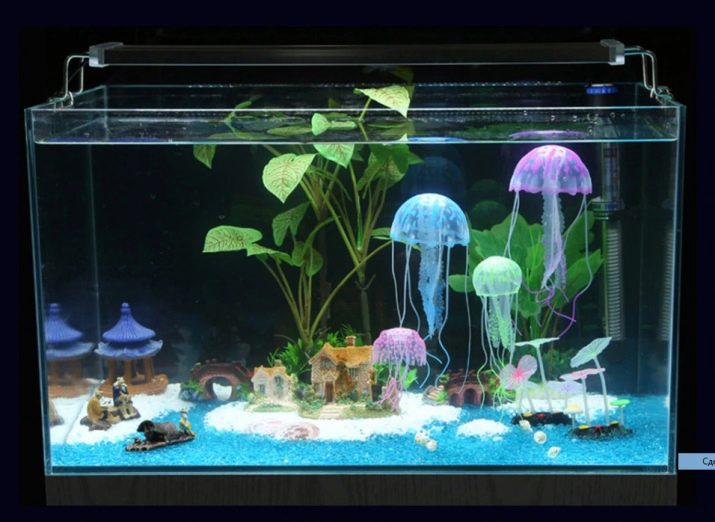
The life path of jellyfish is cyclical, it is divided into several stages.
- Adults periodically throw sperm and eggs into the water, which, when combined, are fertilized, and after a while they turn into a larva (planula). Outwardly, it looks like a ciliate shoe. Planules are attached to rocks or algae.
- The second stage occurs when the larva develops into a polyp.This organism can grow into a large colony, which is not afraid of temperature extremes and many other harmful factors. The polyp is able to take care of itself by forming a podocyte (protective capsule). The body can remain in this state for a long time until the environment becomes favorable for the appearance of small jellyfish.
- At the third stage, when the water temperature is above 25 degrees, the process of jellyfish formation begins from the polyps. In some years, in extreme heat, they accumulate so many that they fall into rivers and rise by the current to places where they have never been seen before. At first, these are very small organisms, no more than 4 mm. Over time, babies grow up and turn into adults.
When growing jellyfish in a home aquarium, it is quite possible to trace all the stages of their development. But the difficulty lies in providing the population with constant live food. A free-swimming jellyfish is able to take care of itself by hunting small crustaceans. It is more difficult to organize the diet of a polyp that is confined to one place. In order for it to receive proper nutrition, the concentration in the aquarium of copepods, brine shrimp and daphnia must be quite high.
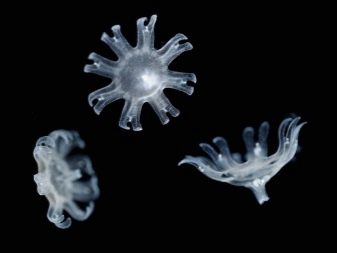

Varieties
Keeping live jellyfish at home is expensive and troublesome. Therefore, many decorate their aquariums with fakes. Imitation products are made from modern, non-hazardous materials; in appearance, they are difficult to distinguish from living individuals.
Lovers of live cnidarians can keep the following types of jellyfish in their aquariums.
- Amakuza. The animal grows up to 10 cm, has long stinging tentacles, with the help of which it hunts for plankton and small jellyfish.
- Aurelia. They are also called moon jellyfish. They live on different continents of the planet in fresh water bodies, river backwaters with a weak current, in a tropical climate. In natural conditions, individuals grow up to 30 cm. Aurelia is the most popular species among lovers of cnidarians. They do not require a lot of light, which helps to curb the rapid growth of algae and effectively illuminate jellyfish in the transparent water column.
- Cassiopeia Mangrove. If the aurelia has a purple or lilac hue, then in Cassiopeia, the transparent body casts a purple or greenish color. Sometimes jellyfish rise to the surface of water bodies to keep warm. For this phenotype, the temperature in the aquarium is kept within 23-26 degrees. These individuals are poisonous and should be looked after with care.
- Papuan. This phenotype prefers water with a low salt concentration. Their body forms a dome 50-60 cm in diameter. They look impressive in aquarium conditions. They feed on plankton, and zooxanthellae are also added as food.
- Ropilem. Large (up to a meter in diameter) jellyfish with a spectacular red tint. They feed on smaller, similar creatures, so they are kept in separate aquariums. At home, jellyfish do not reach one meter in size, but their volumes still remain impressive.
- Sauverby. Dome-shaped jellyfish with a transparent body and a slightly milky shade. They are freshwater, feed on crustaceans, live in warm, neutral water with a light current.
- Filoriza. A transparent jellyfish with white spots that glow mysteriously in the dark. Phyloriza is highly poisonous, only experienced aquarists can keep it. These individuals require large-sized containers for their residence, since they have to pass more than 1000 liters of water through themselves during the day.
- Equorea Crystal. Jellyfish are especially beautiful at night, when they glow with green lights in the dark depth of water. But they can only live in aquariums, as they need a lot of water.

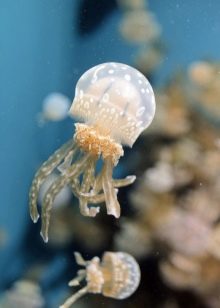

Choosing an aquarium
People have tried for a long time to grow jellyfish in their aquariums, but, unlike fish, they did not take root. The tender bodies were injured on the angular walls of the aquariums, which led to the death of the pets.In addition, to keep them afloat, a weak movement of the water layers is necessary. Keeping jellyfish in captivity was only possible with the invention of the carousel aquarium. Its device allows water streams to constantly move slowly, and this helps jellyfish to be in a "suspended" state.
To prevent pets from hitting the straight walls of aquariums, models for them are chosen with rounded shapes that allow the animals to slide off a sloping surface.
A cylindrical aquarium is considered optimal. In it, with translational rotation, a light stream of water is created, directed tangentially to the walls of the container. The flow rate must be properly adjusted. Too slow movement will lead to the lowering of jellyfish to the bottom, and fast - to their accumulation on the surface. In addition, from active pressure, they will constantly move and get injured.
Aquarium jellyfish are very sensitive to water conditions. Install external or bottom filters and keep the water fresh at all times. Inadequate filters can lead to the suction of the pets themselves, so their choice should be taken seriously. You can use biological purification and run cleaning bacteria into the aquarium, but they, in addition to garbage, will consume nutrients intended for pets, and also release air bubbles. For the delicate body of the jellyfish, aeration is very dangerous, since bubbles accumulating under the dome can damage it.
Lighting should be set for specific types of jellyfish: some like a lot of light, others - twilight.
It is necessary to be guided by the preferences of the inhabitants of the aquarium to maintain the temperature regime: tropical jellyfish require warm water (over 25 degrees), and some species require an environment cooled to 10-17 degrees.

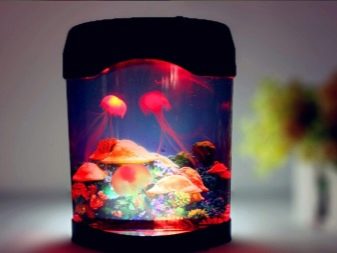
Conditions of detention
One pair of cnidarians requires a container of 40 liters. Water is used of medium hardness, with a neutral pH. For a spectacular presentation of beautiful jellyfish and for their safety, the design of the aquarium should be minimized: just a few bushes of plants and a soil of small pebbles with smooth edges or glass balls. Having prepared the aquarium, you should wait for the completion of the nitrogen cycle, and only then start the inhabitants.
Feeding jellyfish can be challenging for inexperienced aquarists. In the wild, these animals consume large amounts of plankton, nauplii, and brine shrimp. For domestic inhabitants, live food can be purchased at specialty stores, but many prefer to grow plankton on their own. Feeding jellyfish is facilitated by the presence of dry balanced food at home, which is used in combination with a live product.
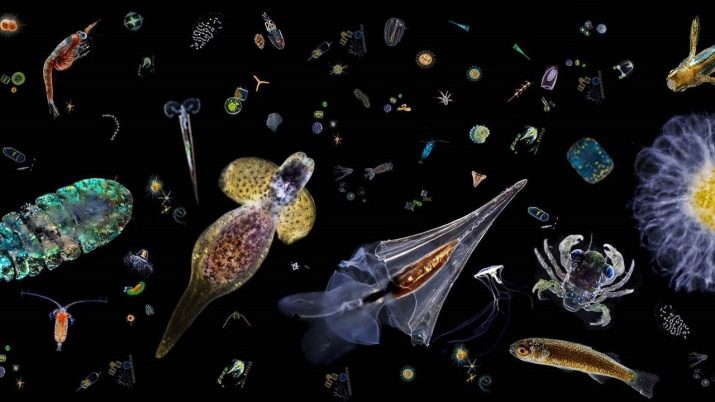
The video will allow everyone to appreciate the size, shape and beauty of jellyfish.








